I guess you could say this whole schebang got started with
Aglaonemas. My mom had a plant with silver markings on the leaves when I was growing up that I liked. It was Aglaonema 'Silver King' I believe. Then about 4 years ago as I started to grow more houseplants on my own I came across two large
Aglaonemas that got me started on the collecting bug. My first real post to this blog was just to post pictures of those
first Aglaonemas. Shortly thereafter I got a comment from a guy named Russ, a stranger in Florida, who
sent me a bunch of plants (for free!) just because he was a cool guy that also liked plants and wanted to encourage me to grow more aroids, which, at the time, I didn't know much about. All I had to do was reimburse Russ for his postage costs. I quickly learned that plant people are very generous and pass along the generosity of those that encouraged them.
Here I am four years later - to the day - posting an update concerning my
Aglaonema collection. Since then, I have added quite a few
Aglaonemas to my collection, while only losing a few along the way. They are really pretty easy plants to grow, while also having some of the most attractive leaves I know.
Here's a rundown of what I have, along with a short description of how each plant is doing, and a picture for most.
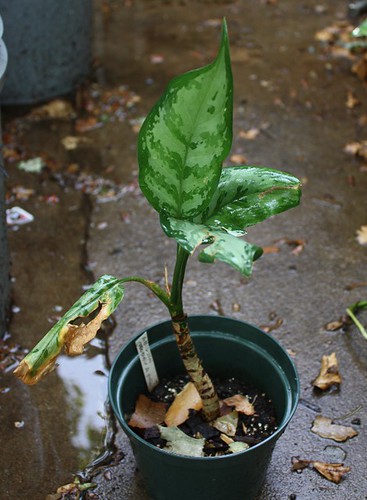 |
| Aglaonema 'Abidjan' |
Aglaonema 'Abidjan': This is an attractive older cultivar. You might wonder why it is named after an African city, when
Aglaonemas are native to southeast Asia. Well, I'm not sure how it got there, but
A. 'Abidjan' was found by an American man growing at a nursery near Abidjan, Ivory Coast in 1974 and brought back to Florida. It is thought that the plant traveled to Africa with a nurseryman from South America. How it got to South America is yet another mystery.
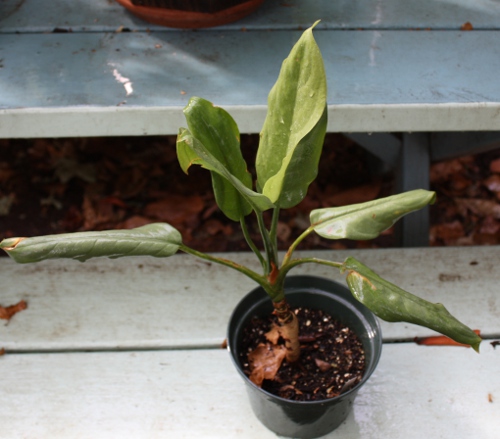 |
| Aglaonema alumina armandii |
Aglaonema alumina armandii: One of my favorites. Silver-blue leaves. Variegation is subtle, if at all. Single stem growing very slowly, with about 4 leaves right now. This plant has an interesting collection history, having been discovered by Armando Cruz (the plant's namesake) near Manila in 1976. It was found on a mountain just covered in this plant, which was given species status 9 years later.
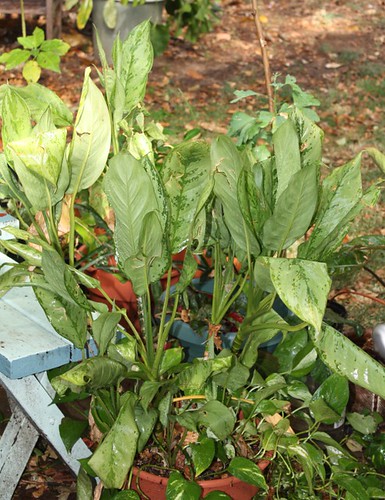 |
| Aglaonema 'BJ Freeman' |
Algaonema 'BJ Freeman': Very healthy large plant with large leaves. This is the biggest plant I have. I have hacked up a couple of the longer, lankier stems to start new plants. My pot has probably 8-10 stems currently, ranging from small and young plants to plants that are 5-10 years old and about 3 feet tall.
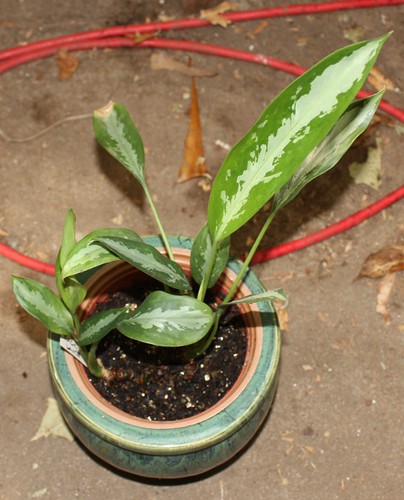 |
| Aglaonema black lance |
Aglaonema 'black lance': Another one of my favorites. My plant was ailing for a while, but I put it in my ICU pot (which I'll describe another time) and now it is doing very well.
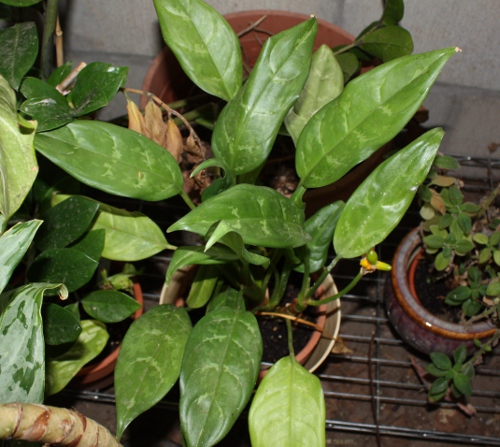 |
| Aglaonema commutatum v. maculatum f. maculatum |
Aglaonema commutatum v. maculatum: This plant is doing pretty well. There are 3 or 4 stems and it bloomed for me for the first time last fall.
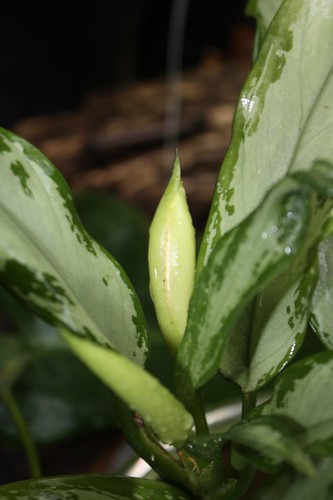 |
| Aglaonema 'Decora' |
Aglaonema 'Decora': This is a very attractive hybrid I picked up at a local nursery. It is a vigorous grower that is currently in bloom.
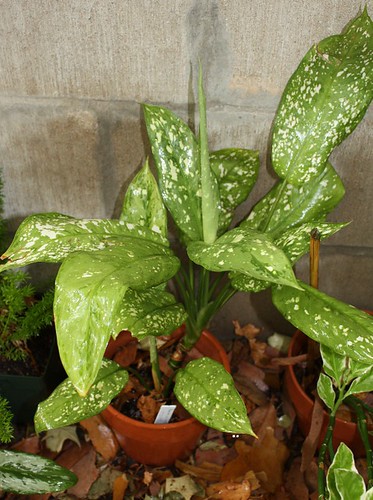 |
| Aglaonema 'Gold Dust' |
Aglaonema 'Gold Dust': I got this plant from a fellow blogger a while back and I would have to say the original stem hasn't grown much since then. However, it has produced a couple of offsets, which is even better than having the original stem growing. This cultivar is based on the species
A. brevispathum.
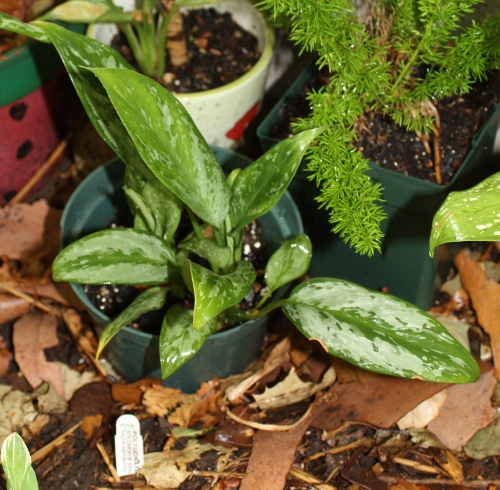 |
| Aglaonema 'Green Lady' |
Aglaonema 'Green Lady': This plant is my most vigorous offsetter. That's probably not a word, but it is producing offsets at a rapid pace. The variegation is really nice on this plant when you stop and look at it. See how many different shades of green you can count. I think there are 4.
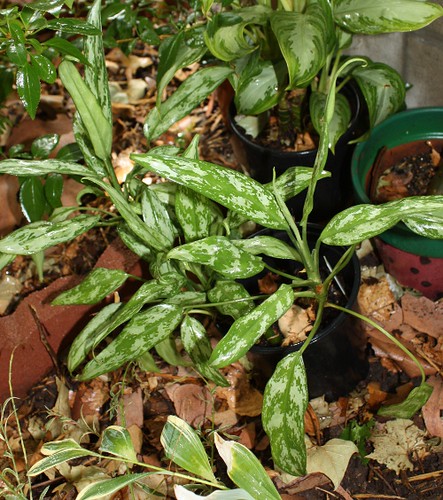 |
| Aglaonema 'Lilliput' |
Aglaonema 'Lilliput': This is a really cool hybrid which has lanceolate (slender, lance-like), undulate (wavy) leaves. The variegation is really nice, too. I shared this plant with some friends, so it is about half the size it would be otherwise.
Aglaonema 'Maria' (not pictured): I have two separate pots of this plant. It is the most common Ag to find for sale. It grows reliably and is very easy to keep happy. For some reason, I have some stems rot on occasion, but usually whatever piece of the stem has not gone mushy will produce it's own plant.
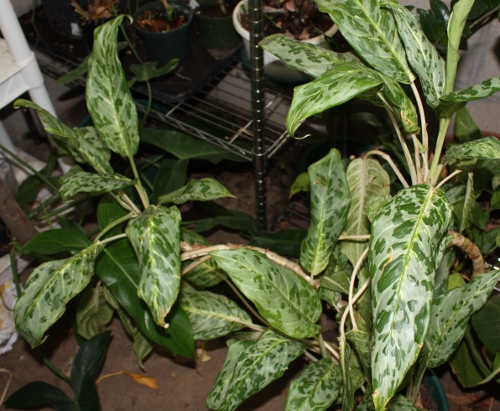 |
| Aglaonema 'Peacock' |
Aglaonema 'Peacock': This is one of my two large Ags. This one was so tall and lanky that I divided it into two pots shortly after buying it. I also took the more lanky stems and cut them into pieces, which produced new plants. Now I have one pot at home and the other resides permanently at the wedding chapel, with a couple of my other plants that are too large to go in my greenhouse.
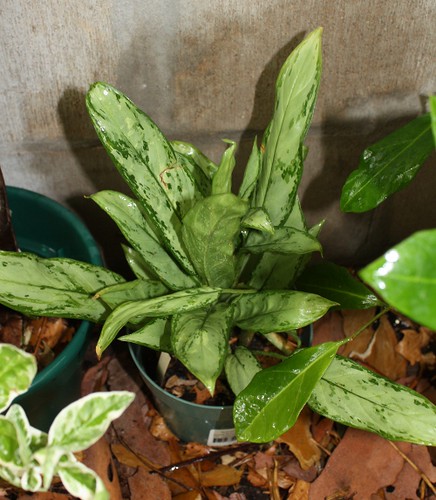 |
| Aglaonema 'Royal Ripple' |
Aglaonema 'Royal Ripple': It's hard to tell in this picture that the leaves are rippled, but they truly are - just like 'Lilliput.' This is one of my more compact, profuse growers. It's a very pretty plant, with lanceolate leaves.
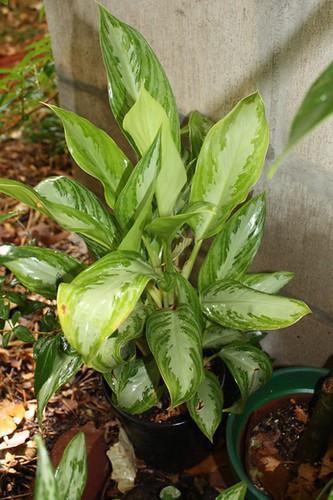 |
| Aglaonema 'Silver Bay' |
Aglaonema 'Silver Bay': This plant is my second most steady grower, producing offsets quite often. It probably has 4 or 5 stems right now.
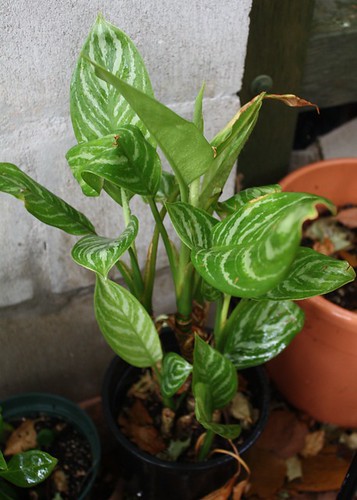 |
| Aglaonema NOID (possibly 'Stripes', 'Cory' or nitidum |
Aglaonema NOID (possibly'Stripes', 'Cory' or
nitidum): There are a number of cultivars and hybrids with stripes like this plant. I haven't nailed down which one mine is, but it definitely has parentage with
A. nitidum, which is the striped species.
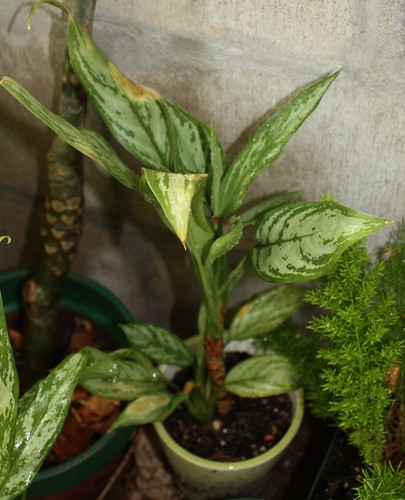 |
| Unidentified Aglaonema |
Aglaonema NOID: I don't really have any idea what this variety is. Maybe 'Maria Christina'? Do you have any ideas which one this is?
My stories come from two hard-to-find books:
The Amazing Aglaonema by B. Frank Brown and
The Aglaonema Grower's Notebook by Roy Jervis.














Z&C,
ReplyDeleteYours is a very nice collection. I have some of those that you have featured in this entry, and some of the more colorful aglaonemas.
I'll try to find time posting some pics of the colorful ones in my webpage. Check it out ---> [http://www.grandesjardines.wordpress.com]
Brian
Brian-
ReplyDeleteI would be very interested in seeing your colorful Aglaonemas. I know that there is a lot of hybridization of these colorful plants being done in Thailand. We don't see them much here in the US, though.
Zach: Sure. Most of the hybrids are in Thailand, though a good number of Aglaonemas endemic here in the Philippines are colorful in their true forms. Cultivar names such as 'Dona Carmen', 'Cory', 'Maria Christina', 'Tandang Sora', etc. are actually some of the most revered women in Philippine history. Will post photos in my page soon :P
ReplyDeleteLove the collection you have put hard work into displaying and describing. I have traveled the world at least 8 times fully around and have found this specimen on literally most continent. And I swear they never look the same from one location to another. My study of them has shown that the elements that each are subjected to develop their own adaptions accordingly. It is mind blogging to have seen so many of same plant, each looking so different. Please note I am not a Botanist, horticulturist , yes. Giving out advice on any of these is a brave and courageous undertaking and I do commend you to have tried to narrow it all down to simplify common understanding.
ReplyDeleteI am sure that your readers would love to know about "SUN CONDITIONS with these plants it is so important where plant is located for optimum growth.Only a suggestion.. you seem to be doing well all on your own.
Keep up the great work you are doing will stop by more often now.Thank you.
Thank you for the info. I've been seeing a lot of this in the surrounding.
ReplyDeletei have a possible aglo alumina armandii... shining shimmering silvery leaveswhen it is healthy & lush
ReplyDelete